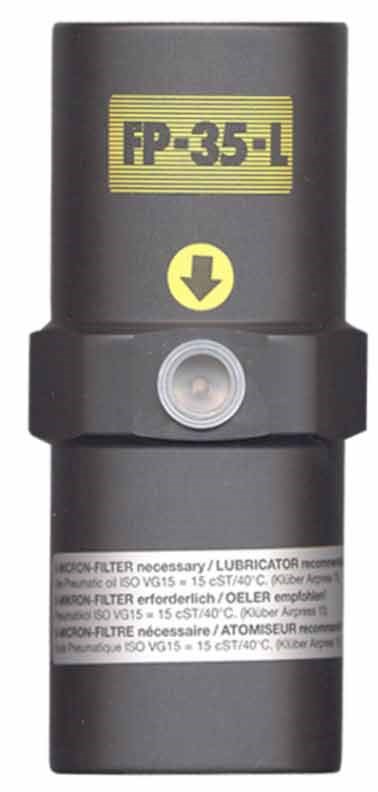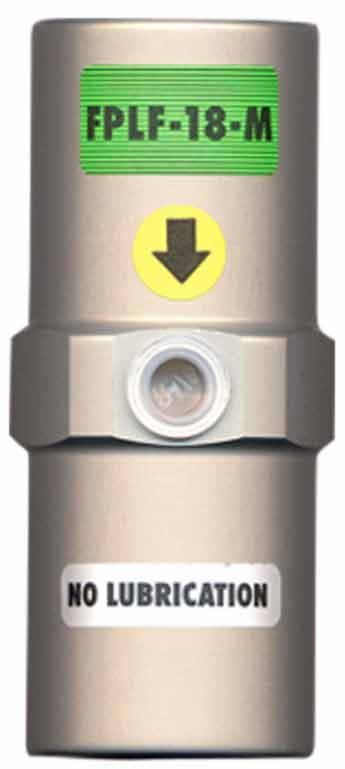Findeva Pneumatic Piston Vibrators
FP Series and FPLF - No Lube Series
About Findeva Piston Vibrators
Piston vibrators use the impact action produced by a moving piston to flex the bin wall. This flexing action loosens material stuck to the wall, allowing gravity to restore material flow. The linear force that is produced works well for material feeding and screening applications.
Findeva piston vibrators are Air-Cushioned piston vibrators only. They use a cushion of air to dampen the piston movement, so the piston reverses direction before impacting the vibrator base. Therefore, Findeva piston vibrators are more quiet than the Impacting piston vibrators (piston actually impacts the base of the vibrator). For more information please see:
- Findeva - FP Performance Data
- Findeva - FPLF Performance Data
- How to Select and Size an Industrial Vibrator
- How to Solve Flow Problems
Advantages of Findeva Piston Vibrators
- Long Life - Anodized aluminum body and leaded bronze piston provide corrosion resistance and minimize piston and cylinder wear for extended life.
- Small, Lightweight - Hard anodized aluminum alloy body.
- Trouble-Free Operation - No required maintenance if using filtered air for the FPLF models and filtered lubricated air for the FP Series.
- Spring ensures reliable start-up in all mount orientations.
- No lubrication needed for the FPLF series.
- Clean Operation - FPLF models produce no oily mist because no lubrication is required. Special piston treatment is self-lubricating.
- FPLF Pistons meet FDA guidelines. Designed specially for the pharmaceutical and food industries.
- Quiet Operation - Expertly designed exhaust system absorbs sound producing only 60-75 dBA. Much more quiet than other pneumatic vibrators.
- Air-Cushioned Models - Quieter than Impacting Models because a cushion of air eliminates metal-to-metal impact.
- Highly Efficient - Use less than 6 CFM, even for largest models.
- Easy to Mount - Threaded base for mounting.
- Versatile - Easy to control force and frequency by adjusting air supply.
Specifications

FP-Series
- Requires filtered air.
- 20- 90 psi (1.4 - 6.2 bar) depending on model.
- .02-7.0 CFM (.56 - 198 LPM)
- Lubrication required
- 60-75 dBA with mufflers
- Pipe thread is BSP (British Standard Pipe) but will accept NPT (National Pipe Thread).
- Maximum Ambient Temperature up to 302°F (150°C).
- Findeva FP Operations Manual
- Finveva FP Piston Dimensions & Drawings

FPLF-Series
- Requires filtered air.
- 20-90 psi (1.4 - 6.2 bar) depending on model.
- .02-5.0 CFM (.56 - 142 LPM).
- No lubrication required. Grease recommended after 1,500 hours of use. Grease sparingly when it is disassembled.
- 60-75 dBA with mufflers
- Pipe thread is BSP (British Standard Pipe) but will accept NPT (National Pipe Thread).
- Maximum Ambient Temperature up to 185°F (85°C).
- Findeva FPLF Operations Manual
- Findeva FPLF Piston Dimensions & Drawing
Accessories
- Manual Valves:
- 2-way manual ball valve used to turn the vibrator on and off for normal operation.
- 3-way manual ball valve used to turn the vibrator on and off when rapid on/off/on operation is required.
- Solenoids - For remote or automated control
- Use 2-way normally closed solenoid valve to turn the vibrator on and off for normal operation.
- Use 3-way normally closed solenoid valve when rapid on/off/on operation is required.
- Airline Kits Required for trouble-free operation and long life of piston vibrators:
- FRGL - Includes airline filter, lubricator, and pressure regulator with gauge for all FP models.
- FRG - Includes airline filter and pressure regulator with gauge models for all FPLF models.
- Sirometer - Convenient, compact rpm meter for measuring vibrator speed.
Vibrator Selection
Since piston vibrators create material flow by flexing the bin wall, selection of the proper vibrator is based on the bin wall thickness. The thicker the wall the bigger the vibrator needed. If selecting a more quiet Air-Cushioned model you generally use one size larger than an Impacting model sized for the same application. Selection is also based on the combined weight of the chute or moving part of screen and the material inside. Please see: